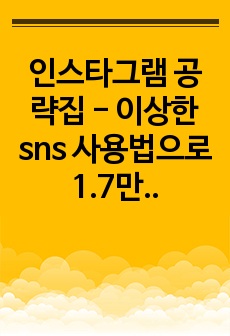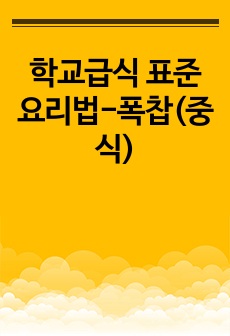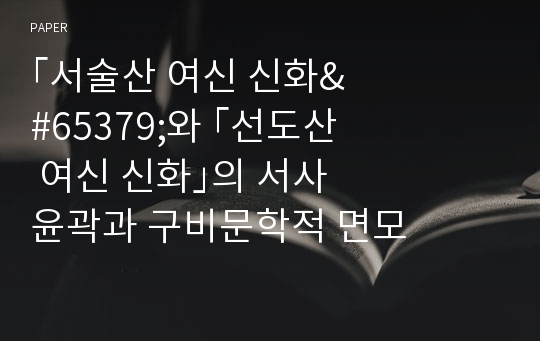「서술산 여신 신화」와 「선도산 여신 신화」의 서사 윤곽과 구비문학적 면모
* 본 문서는 배포용으로 복사 및 편집이 불가합니다.
서지정보
ㆍ발행기관 : 한국구비문학회
ㆍ수록지정보 : 구비문학연구
ㆍ저자명 : 윤혜신
ㆍ저자명 : 윤혜신
목차
1. 서술산 여신과 선도산 여신의 동일성 논의2. 「선도산 여신 신화」와 「서술산 여신 신화」의 서사적 윤곽
3. 시간의 흐름과 서사의 누적적 형성
참고문헌
한국어 초록
이 논문은 서술성모와 선도산 신모를 동일한 여신이 아닌, 서로 다른 여신으로 파악한선행 연구의 관점을 계승하면서, 상대적으로 미진했던 문학 측면의 연구를 보강하려는 시
도에서 이루어졌다. 결론적으로 「서술산 여신 신화」는 서사가 형성된 이래 1000년 이상의
시간을 거치면서 최소한 5차에 걸친 변개가 이루어졌으며 「선도산 여신」는 2차에 걸친 변
개가 적층적으로 이루어졌다. 각각의 서사가 갖추었을, 최소한의 윤곽을 이 논문의 결론부
에서 제시하였다. 여신 서사가 변개되는 과정을 통해 일정한 시선과 세계관에 의해 서사가
사후적으로 재구성되는 구비문학적 면모를 볼 수 있다.
박혁 거서간 탄생담에 언급된 여신은, 시간적 위상을 고려해볼 때 선도산 여신이 아니라
서술산 여신이라고 보는 것이 타당하다. 「선도산 여신 신화」는 고려 시기에 중국으로부터
김부식에 의해 전해졌으므로 박혁 거서간의 탄생담에 등장하는 신라 건국 즈음의 여신은
시기상 서술산 여신일 수밖에 없기 때문이다. 따라서 「서술산 여신 신화」가 고려 시대에
전해진 「선도산 여신 신화」보다 오래되었을 것으로 추정된다.
또 여신 신화가 기록된 초기 문헌인 삼국사기 와 삼국유사 의 기록을 받아들일 경우,
논리적 모순이 생겨 여신 서사를 재배치할 필연성이 생긴다. 삼국사기 에 없는 솔개·황
제 개입 모티프 등의 몇몇 모티프가 삼국유사 에서 발견되는 사실에서 각 시기의 구비전
승자가 여신 신화를 바라본 사후작용의 시선, 세계관의 차이가 감지할 수 있다. 여신 신화
에는 신화적 세계관, 불교적 세계관, 도교적 세계관이 혼재되어 있는데 주체와 세계관에 따라 서사적 사건을 분리하면 두 여신의 서사가 다른 경로를 거쳐 형성되었음이 드러난다.
라캉주의 이론을 원용하여 서사 변개의 당대적 의미를 살펴보면, 여신 서사가 재구성되
면서 신화적 여신의 기표(signifier)가 불교적 여신, 도교적 여신, 불교를 옹호하는 도교적 여
신 등 다양한 여럿이 되고 이 기표 덩어리가 새로운 기의(signified)인, 전래의 권위와 도교
적 권위를 아우르는, 강력한 권위를 가진 불교적 여신의 의미를 발생시켜 당시의 고려 사회
에 상당한 정치적 파급 효과를 미쳤을 것으로 해석된다.
영어 초록
As oral literature, a myth generally tends to have various versions of thedifferent times. This study intended to arrange narrative’s line of two myths
of goddess which has various temporal features. From the temporal features,
‘antiquity’ of myth at the time of pre-ancient kingdom and ‘the ancient feature’
at the time of ancient kingdom are searched. In widespread narratives after
13C, a goddess of ancient kingdom Shilla, Holy mother Seosul[Seosul-seongmo],
would be called in the name of the goddess Seondo[Seondosan-sinmo]: Two
character, one identity. This understanding became popular after the 13C book
“Samguk yusa” and subsequent Josun dynasty’s various books.
However, these myths are difficult to see as myth of same goddess. Different
world views are perceived : Mythological world view, Buddhist world view,
Taoistic world view. It could be presumed two myths had been formed
through separate courses.
To examine the separate courses, according to main character of Seosul and
Seondo, episodes were divided. Over the several motifs and episodes, logical
questions were arisen : Why the version of “Samguk yusa” has different motifs, like hawk, Chinese emperor, emperor’s letter etc., while “Samguk yusa” quoted
“Samguk sagi” which delivered the Seondo myth for the first time in Koryo.
As an answer of the question in this study, the motifs, episodes were analysed
by their temporal features and were belonged to a proper myth.
In conclusion, the myth of goddess Seosul had been changed at least 5
times through more than 1,000 years from the first formulation of prehistoric
time, before Ancient kingdom Shilla to 13C(cir. 1281 A.D.), in which the myths
were recorded in “Samguk-yusa” of Koryo dynasty.
- The first version of Seosul myth : Antiquity of myth before ancient
kingdom with nature worship in a short narrative.
- The second version : Birth episode of Shilla Geoseogan[king] Park Hyeok
was added(cir. 57 B.C.E. according to a history book “Samguk-sagi”).
- The third version : Buddist episode was added(cir. 565-632 A.D.) by
the buddist king.
- The fourth version : Episode of king Kyeongmyong and a hawk was
added. (cir. 924 A.D.)
- The fifth myth : goddess Seosul and goddess Seondo regarded as the
same identity.(cir.1281 A.D.)
Meanwhile, the myth of goddess Seondo was delivered from China in Koryo
dynasty (cir.1145 A.D.) by Kim Busik, the author of “Samguk-sagi”. Therefore,
logically, goddess Seondo could not been a narional mother goddess of Shilla,
the country before Koryo. With very political reason to reinforce the power
of Buddism, the second variation was made by Il Yeon, the author of
“Samguk-yusa”. He intended to use the traditional dignity of Seosul and make
Taoistic Seondo as Buddism supporting goddess. So, one powerful goddess
were born. After this version, two goddesses would been regarded as one goddess.
Through variations of two goddesses myths, several signifiers based on
various world views and beliefs could had been clustered and made new
meanings[signified] which had political power and influenced to the opposing
group off the author Il Yeon.
Those interpretations can be understood as post-evental interpretation with
premises of Lacanian pychoanalysis perspective. It means through various
signifiers, a goddess of mythological gained new meanings over the first
mythical meaning. The signifiers such as ‘a goddess surpporting buddism’, ‘a
goddess who has divine power over the nature’, ‘Taoistic goddess’ could
generate the new signified by metaphor.
참고 자료
없음태그
"구비문학연구"의 다른 논문
 동북아 혼쥐설화 유형의 비교연구44페이지
동북아 혼쥐설화 유형의 비교연구44페이지 설화 <도량 넓은 남편>을 활용한 창작활동의 치유적 가능성43페이지
설화 <도량 넓은 남편>을 활용한 창작활동의 치유적 가능성43페이지 근대 재담집 『소천소지(笑天笑地)』 연구 : ― 등장인물의 관계 양상과 그 특징을 중심으로 ―47페이지
근대 재담집 『소천소지(笑天笑地)』 연구 : ― 등장인물의 관계 양상과 그 특징을 중심으로 ―47페이지 근대 ‘야담가’의 존재와 구연 활동35페이지
근대 ‘야담가’의 존재와 구연 활동35페이지 근대초기 재담과 로컬리티의 문제38페이지
근대초기 재담과 로컬리티의 문제38페이지 용궁설화에 나타난 증여의 논리와 호혜적 연대의식37페이지
용궁설화에 나타난 증여의 논리와 호혜적 연대의식37페이지 가요 개념의 근대화, 식민화, 혼종화30페이지
가요 개념의 근대화, 식민화, 혼종화30페이지 中國民間敍事与民間故事講述人學術硏討會 綜述 중국 민간서사 및 민담 구연자에 관한 학술대회..15페이지
中國民間敍事与民間故事講述人學術硏討會 綜述 중국 민간서사 및 민담 구연자에 관한 학술대회..15페이지 근대전환기 패설의 변환과 지향31페이지
근대전환기 패설의 변환과 지향31페이지 구전이야기 ‘다시쓰기(Re-Writing)’를 활용한 자기탐색 글쓰기 교육58페이지
구전이야기 ‘다시쓰기(Re-Writing)’를 활용한 자기탐색 글쓰기 교육58페이지

























